




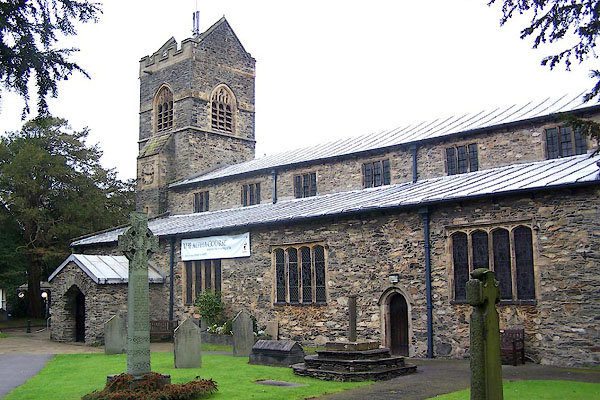
BJX41.jpg (taken 7.10.2005)
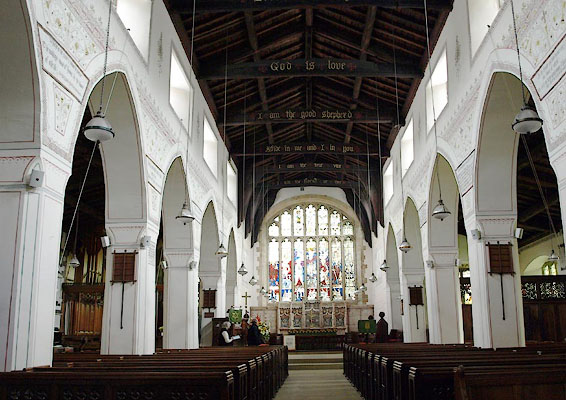
BRL37.jpg (taken 18.9.2009)
placename:- St Martin's Church
"St Martin's Church (Rectory)"
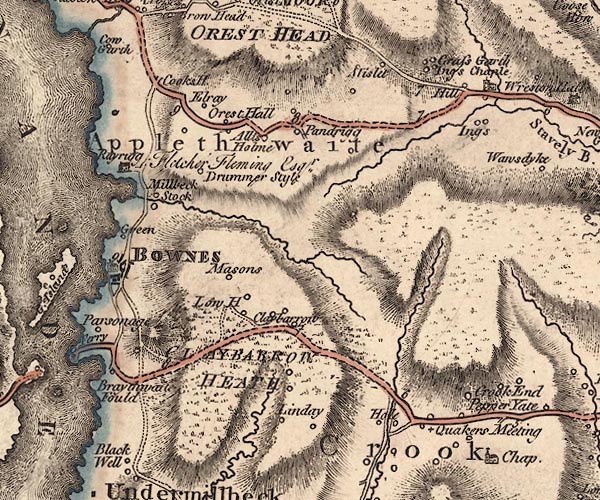
J5SD49NW.jpg
church
item:- National Library of Scotland : EME.s.47
Image © National Library of Scotland
item:- stained glass
 goto source
goto sourcePage 73:- "..."
"In Bowness there is nothing so remarkable as some remains of painted glass, in the east window of the church, that were brought from the abbey of Furness [1]."
"[1] 'The present remains of this window show that it has contained very fine colouring in its former state. The arms of France and England quartered, are well preserved at the top of the window. The design is a Crucifixion, in figures as large as life. By the hands, feet, and parts remaining, it seems to have been of singular beauty. On the dexter side of the crucifixion, is St. George slaying the Dragon; on the sinister, the Virgin Mary;- an uncouth assemblage. Beneath, are the figures of a knight and his lady kneeling, before whom are a group of kneeling monks, over whose heads are wrote W. Hartley, Tho. Honton, and other names, by the breaking of the glass rendered not legible.'- Hutchinson's Excursion."
item:- stained glass; coat of arms; Carrier's Arms; charity; bread, charity
 goto source
goto sourcePage 140:- "..."
"... Bowness, ... In this village stands the mother church of the parish of Winandermere; it is large old building, with a great quantity of painted glass in the East window, which is said to have come from Furness Abbey. Mr West says of it, in his Antiquities of Furness, p.95. "The window consists of seven compartments, or partitions. In the third, fourth, and fifth, are depicted the crucifixion, with the virgin Mary on the right, and the beloved disciple on the left side of the cross. Angels are expressed receiving the sacred blood from the five precious wounds, and below the cross are a group of Monks in their proper habits, with the abbot in a vestment: their names are written on labels issuing from their mouths; the abbot's name is defaced, which would have given date to the whole. In the second partition are the figures of St George and the Dragon. In the sixth is represented St Catharine, with the emblems of her martyrdom, the sword, and wheel. In the seventh are two figures of mitred abbots, and underneath them two Monks dressed in vestments. In the middle compartment, above, are finely painted, quarterly, the arms of England and France, bound with the garter and its motto, probably done in the reign of Edward the III. The rest of the window is filled up by pieces of tracery, with some figures in coats armorial, and the arms of several benefactors.""
"There is a piece of painted glass on the window on the North side, called the Carrier's Arms; which is a rope, a wantey-hook, and five packing pricks, or skewers, being the implements which carriers use to fasten their packing sheets together. The inhabitants have a tradition in this place, which will, if true, amply account for the carriers"
 goto source
goto sourcePage 141:- "arms, as they are called, in this North window: Indeed traditions have usually some foundation in truth; and this has, besides, such an air of probability, that I am tempted almost to believe it. When this church wanted to be rebuilt, together with the chapels of St Mary Holm, Ambleside, Troutbeck, and Applethwaite, which were all destroyed, or rendered unfit for divine worship, the parish was extremely poor; the parishioners, at a meeting, agreed that one church should serve the whole. The next question was, where it should stand? The inhabitants of Under-Mill-Beck were for having it at Bowness; the rest thought that as Troutbeck bridge was about the centre of the parish, it should be built there. Several meetings in consequence were held, and many disputes and quarrels arose: at last a carrier proposed, that whoever would make the largest donation towards the building, should chuse the situation of the church. An offer so reasonable could hardly be refused, and many gifts were immediately named: the carrier, (who had acquired a fortune by his business) heard them all, and at last declared, that he would cover the church with Lead. This offer, which all the rest were either unable or unwilling to outdo, at once decided the affair: the carrier chose the situation, and his, (or more properly his implements) were painted on the North window of the church. Tradition adds, that this man obtained the name of Bellman, from the bells worn by the fore-horse, which he first introduced here: the name of Bellman yet remaining in this place, and the singularity of this church being covered with lead, when all the rest hereabouts are covered with the beautiful white slate, give additional probability to this story."
"This church is dedicated to St Martin; the patronage is in Sir Michael le Fleming, Baronet of Rydale-Hall, and is within the bishoprick of Chester. There is also a school-house for the inhabitants of Under-Mill-Beck and Applethwaite, with about seventeen pounds a year salary. There are, besides, several donations to the poor to a considerable amount, distributed in money, meal, and bread. In the year 1742, Edward Bellman, Thomas Collinson, and Robert Dixon, gave twenty-two dozen of loaves to the poor of this parish yearly, to be distributed equally every Sunday at the church, immediately after divine service, by the church-wardens."
item:- stained glass; coat of arms
 goto source
goto sourcePage 155:- "..."
"The choir of the parish church of Windermere is adorned with a beautiful window, said to have been purchased by the parishioners from Furness abbey at the dissolution, representing in seven compartments the Crucifixion, St. George and St. Catharine, and two mitred abbots, with the arms of England t. Edward III. and of various benefactors."
item:- stained glass
 goto source
goto source"[Undermilbeck] ... In this town stands the church of Windermere, a large and handsome building, the windows of which contain some beautiful paintings on glass, brought from Furness Abbey."
"..."
item:- stained glass
 goto source
goto sourcePage 4:- "... The church [at Bowness] possesses some painted glass, brought from Furness Abbey; and its cemetery contains the remains of the late Bishop Watson. ..."
item:- monument; stained glass
 goto source
goto sourceGentleman's Magazine 1825 part 1 p.516 "Compendium of County History. - Westmorland."
"... The church contains monuments and inscriptions to the Philipsons of Calgarth and other eminent families in the neighbourhood. Its chancel window belonged to Furness Abbey. It consists of seven compartments, representing the Crucifixion in the 3d, 4th, and 5th. In the 2d is St. George; in the 6th, St. Catharine, and in the 7th, two mitred abbots and two monks. The colouring is very fine."
 goto source
goto sourcePage 28:- "..."
"[Bowness] ... The church, dedicated to St. Martin, is a large white edifice, with a low square tower. It consists of a nave, separated from its aisles by pointed arches, springing from piers unadorned by capitals, and the roof"
"'-- Upheld
By naked rafters intricately cross'd,
Like leafless underboughs, 'mid some thick grove,
All wither'd by the depth of shade above.'"
"The east window of the chancel is large, and filled with fine old painted glass, brought from Furness Abbey; by its present arrangement, however, the effect is very diminished. Among the monuments are some belonging to the Philipsons, the ancient possessors of Calgarth. By far the most interesting is that to Dr. Watson, late Bishop of Llandaff, who lies buried at the east end of the churchyard,"
 goto source
goto sourcePage 29:- "with the following plain inscription:- 'Ricardi Watson, Episcopi Landavensis, cineribus sacrum; Obiit Julli 1, A.D. 1816: Aetatis 79.' The rectory is on the banks of the lake, along whose shore the glebe land extends to some length."
item:- weather; Paraphrase on the New Testament; Defence of the Apologie of the Church of England; poor box; pulpit
 goto source
goto sourceGentleman's Magazine 1849 part 2 p.585 "WINDERMERE, OR BOWNESS, CHURCH, WESTMERLAND."
"IT was one of those variable days so characteristic of the early spring, that, in furtherance of my object of collecting information respecting the old family of the Philipsons who in feudal state formerly owned the adjoining hall of Calgarth, I made an excursion to the parish church of Windermere, to examine the monument it was understood to contain, commemorative of an individual of that extinct house. The weather was bitingly cold, with frequent showers of snow and hail, which for moments totally obscured the face of the country. The gale whitened the dark waters of the lake, and caused their tiny billows to lash the sounding shores with the mimic fury of an ocean tempest; yet, immediately succeeding these violent gusts, the vernal sun shining in the blue heavens, would again light up the wide-spreading landscape with a brilliancy the more remarkable by its contrast to the gloom of the hurricane, which soon had swept afar. Much and often as I had admired the scenery of the justly-celebrated lake, which has become almost a proverb for its attractions, I never beheld its glorious expanse to greater perfection than from the road which, branching from the highway to Kendal, leads along an undulating elevation to Bowness; and never did the appearance of its upper reach so strongly impress me with its resemblance to the luxuriant glory of those Italian lakes, which have been so exquisitely rendered by the pencil of that glowing transcriber of nature - our English Stanfield."
"The church of Windermere, a venerable and spacious erection, dedicated to St. Martin, is in the centre of the small and somewhat foreign-looking village of Bowness. It is the only relic remaining of our forefathers in this pleasing spot, though Bowness can lay claim to a considerable antiquity, ... its sunlit tower, rising among trees, Gothic gables, and the campaniles of tasteful buildings,"
""Like one that seeketh, through the years gone by,
For some lost hope that was surpassing fair,""
"has a beautiful and picturesque effect. It stands almost on the margin of the water, on the edge of what was once the village green, and within a burial ground, whose verdant sward is nearly surrounded by the sombre foliage of a number of flourishing yew trees, under whose shade the sumptuous tombs, which human pride has erected over its kindred dust, are glaringly contrasted with the numerous grassy hillocks that mark the resting places of the simple forefathers of this pretty hamlet. ..."
"Of the date when the church was founded there are not, it is supposed, any records in existence that speak with certainty. In ages long ago, the parish, like that of Grasmere, was a chapelry only, within the parish of Kendal; but through the length of time, and little or no communication with the mother church, by reason of the distance, it acquired the reputation of a distinct parochial division. It is nevertheless stated that in token of subjection to the mother church, the rector of Windermere pays to this day an annual pension of 13s. 4d. to the vicar of Kendal. At the appropriation of the church of Kendal to the abbey of St. Mary, in York, by Ivo de Tailbois, first baron of Kendal after the Conquest, the patronage of Wynandermere chapel, as it was called, was excepted. In Edward the Third's time the patronage was in Ingelram de"
 goto source
goto sourceGentleman's Magazine 1849 part 2 p.586 "Guisnes and his wife Christian, who were grantees of the Crown, but subject to a pension of 33s. 4d. payable to the said abbey. It appears to have become subsequently vested in Joan de Coupland, as by an inquisition taken in 49 Edw. II. after her death, it was found that she held by grant of the king during her life the advowson of Wynandermere, then valued at 100s. The patronage afterwards reverted to and continued in the Crown till the seventh year of Queen Elizabeth, when it was granted to William Herbert and John Jenkins, to hold of the queen in free socage by fealty as of the manor of East Greenwich. After several mesne conveyances it was in the last century purchased by Sir William Fleming, of Rydal, bart. who devised it to his four daughters, from who it has descended to the Rev. Sir Richard Fleming, of Grasmere, baronet."
"The church consist of an embattled square tower, carrying a peal of three bells, into which a low recessed arched doorway, not now used, gives access to the western front. A vestry, of modern addition, at the west end of the north aisle, whose original integrity of form it totally mars. A nave, with north and south aisles. A porch, at the south side, through which is the principal entrance into the church. A narrow arched door is near the east end of the same aisle, and a door of like design near the west end of the north aisle. The south aisle is lighted on the flank wall by four square stone-mullioned windows of four round-headed lights each, while the windows in the wall of the north aisle are five in number with three lights only. At the west end of the south aisle and east end of both aisles there are larger windows of similar form of four lights each, in some of which a few remnants of ancient coloured glass are observable. Besides these windows additional light is admitted from six clerestory windows on each side of three lights each; but that which contributes most to illuminate the interior is the large semicircular-headed east window, which is of great size, of the latest and most debased Perpendicular, and divided by plain stone mullions into seven lights."
"On entering I found myself within a large structure devoid of any particular architectural distinction, but interesting from its antiquated and hallowed character. The arches dividing the nave from the aisles are pointed and square-edged, and spring from square multangular piers that are without imposts or mouldings. So much however are they enveloped with the defilement of plaster and whitewash, that their original form or ornamental details, if of the latter they ever had any, cannot be defined."
"..."
"The disfigurement of pews and seats of all shapes and sizes are also to be seen; and a gallery has been introduced into this part of the church. A mean wooden altar-piece, painted light blue, on which the Lord's Prayer, Creed, and Commandments are inscribed, occupies the space underneath the great window, and hides the lower portion of it from observation."
"The roof, which is open to the framing, is of oak, black through age, and"
 goto source
goto sourceGentleman's Magazine 1849 part 2 p.587 "covered on the outside with lead. Some years since it narrowly escaped being altogether concealed from view; as a wealthy individual, desirous to render the church snugger, and more in accordance with modern ideas of comfort, proposed to shut out this dark-looking roof, by putting up a smooth lathe-and-plaster ceiling at his own expense. The tasteless attempt however was fortunately frustrated by the zealous care of one of the churchwardens, to whom the antique appearance and keeping of the sacred edifice was an object of reverential regard."
"In the church is kept, it cannot be said preserved, chained to a seat underneath the reading-pew, a copy of Erasmus's "Paraphrase on the New Testament," which Cranmer caused to be introduced into all the parish churches in England, and which book was one of the first of those successive publications by whose aid he restored and built up the Reformed faith of his country. There is also a copy of Jewels' "Defence of the Apologie of the Church of England," which in Queen Elizabeth's reign was likewise ordered to be similary placed. These books are in bad condition, as some of the leaves have been loosened, the title pages of both partly torn out, and deprived of their clasps and bindings; they are tossed together upon a seat, as things altogether disregarded and abandoned to the pleasure of every spoiler. Through similar want of care the Coverdale Bible, printed in 1535, a copy of which was in Henry the Eighth's reign, A.D. 1538, enjoined by Cromwell, the King's Vicar-general, to be deposited in the choir or chancel of all the Reformed churches in England, for every one to read at his leisure, has been removed and lost."
"The chest for alms, which at one time was so general an article of church furniture, fixed on a stone or pillar in some convenient situation at the west end of the nave, near the entrance, is now likewise thrown by in the vestry."
"Pity it is, that those to whom the church and its appendages are by the law yearly entrusted should so little appreciate these old and faithful remembrances of the pious anxiety of the Fathers of our Reformation, ..."
 goto source
goto sourceGentleman's Magazine 1849 part 2 p.589 "..."
"The Font, which is of pale red sandstone, is of an octagonal form, and on some sides of the bowl or head small and rudely sculptured faces may be traced. On occasion of putting up additional pews against the west end of the nave, it was found partly built into the wall, and encrusted with plaster. Having been cleansed and purified of its disguise, and placed on a new shaft of lighter coloured stone, raised on steps of a corresponding form, it has lately been removed to the position it now occupies near the principal entrance."
"There is also to be noticed at the east end, on the soffit of the second arch of the south aisle, within a coloured and rudely ornamented label, the following inscription in black letters, which is partly effaced by the whitewash brush:-"
"[ ]
[ ] est ille dies renovari
celebrior anno
[ ]em facit, et proprio
[ ]gnat amore deus
[ ]boni stigiis quae
coniurata tenebris
[]unc mala divina
fabula facta manu
Anglia mole suae mox
aspicienda ruinae
[ ]ut aetherea
libera mansit ope.
Exultat Anglia.
Faucibus eripior Fauxis
quasi carcere mortis,
Gloria in excelsis
hinc mea tecta salus.
Christoferus Philipson
Junior Generosus, 1629."
".................."
 goto source
goto sourceGentleman's Magazine 1849 part 2 p.590 ".................."
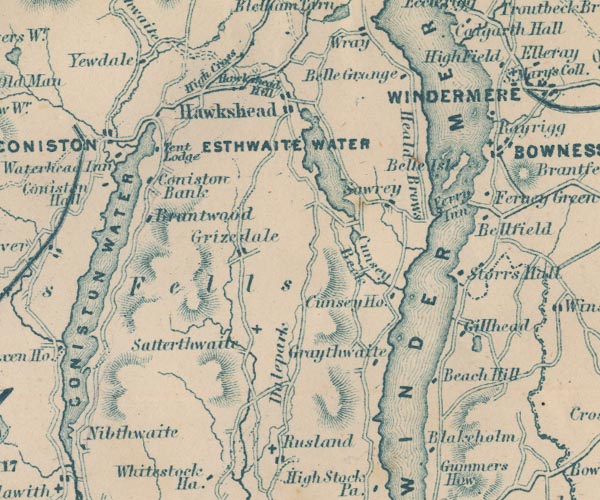
GAR2SD39.jpg
cross, a church
item:- JandMN : 82.1
Image © see bottom of page
item:- stained glass
 goto source
goto sourcePage 11:- "The old churchyard of Bowness, with its dark yews, and the weather-worn church, long and low, is the most venerable object in the place. The chancel window of the church contains painted glass from Furness Abbey. The tomb of Bishop Watson will be found in the churchyard, near the east window. ..."
placename:- Bowness Church
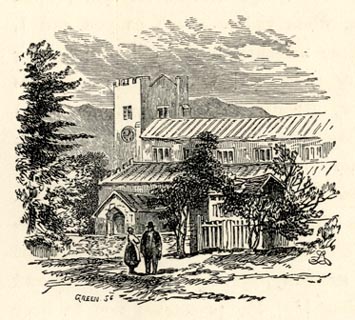 click to enlarge
click to enlargePN0308.jpg
On p.13 of The Lakes in Sunshine, text by James Payn.
item:- Fell and Rock Climbing Club : 184.8
Image © see bottom of page
item:- lych gate
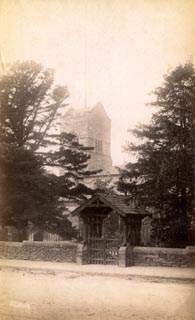 click to enlarge
click to enlargeHB0809.jpg
internegative at lower left:- "H. Bell"
item:- Armitt Library : ALPS472
Image © see bottom of page
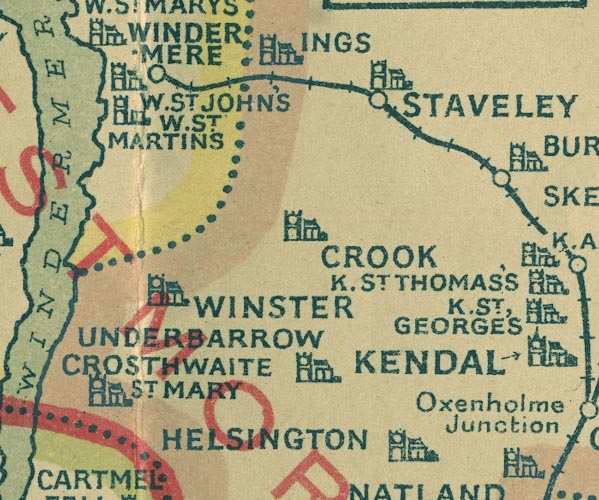
NUR1SD49.jpg
"W. ST. MARTIN'S"
item:- JandMN : 27
Image © see bottom of page
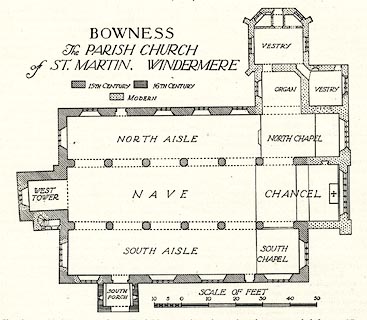 click to enlarge
click to enlargeHMW034.jpg
On p.45 of the Inventory of the Historical Monuments in Westmorland.
printed, upper left "BOWNESS / The PARISH CHURCH / of ST. MARTIN, WINDERMERE"
RCHME no. Wmd, Bowness on Windermere 1
item:- Armitt Library : A745.34
Image © see bottom of page
 stained glass
stained glass kneelers
kneelersplacename:- Church of St Martin
courtesy of English Heritage
"PARISH CHURCH OF ST MARTIN / / LAKE ROAD / WINDERMERE TOWN / SOUTH LAKELAND / CUMBRIA / I / 351692 / SD4025296904"
courtesy of English Heritage
"A church has been on this site since 1203. Present building circa 1480. Upper part of tower and east end added 1870. Built of local slate rubble with sandstone dressings. Very sturdy arcade piers. All walls painted with verses, scrolls etc, some C17, some Victorian. Some mediaeval glass. A Flaxman monument. Painted Royal Arms of 1761."
"Parish Church of St Martin forms an important village centre group with No 1, Premises occupied by Hairdresser, Old Kirk Cafe, Old Curio Shop, Stags Head Inn and Rose Cottage, Church Street and White House, Robinson Place, New Hall Inn with attched buildings to south, Lowside and Fold Head, Fallbarrow Road."
courtesy of English Heritage
"TOMB OF RASSELAS BELFIELD IN ST. MARTIN'S CHURCHYARD / / LAKE ROAD / WINDERMERE TOWN / SOUTH LAKELAND / CUMBRIA / II / 504662 / SD4027896901"
courtesy of English Heritage
"The tomb of Rasselas Belfield stands near the edge of the churchyard of St Martin, Bowness on Windermere, approximately five metres from the east end of the church. Dated 1822. Rectangular headstone, with shouldered triangular top. Above the inscription is an incised scrolled design. The clear inscription reads:"
"IN MEMORY / of / RASSELAS BELFIELD / a Native of / ABYSSINIA. / Who departed this Life on the / 16. Day of January 1822, / Aged 32 Years. // A Slave by birth I left my native Land / And found my Freedom on Britannia's Strand: / Blest Isle! Thou Glory of the Wise and Free, / Thy Touch alone unbinds the Chains of Slavery.'"
"HISTORY: According to W. Sayer's 'History of Westmorland', written in 1847, the young man commemorated by this headstone was brought to England by a Major Taylor, who had bought him as a child from his mother for the equivalent of about L5. Taylor is said to have been engaged, with his regiment, in the campaign of the East India Company Army against Tippu Saib, celebrated ruler of Mysore, South India, which culminated in Tippu's death in 1799. The headstone's inscription describes Rasselas as 'A Native of Abyssinia', suggesting that he was born there, and it may be that Taylor travelled back to England by way of Abyssinia (now Ethiopia), and acquired Rasselas then. On the other hand, Abyssinian slaves and solders - 'Habshis' - had been brought to India from the C15 onwards, and consequently a large number of people in that country had Abyssinian roots. It is possible that Rasselas entered Taylor's service whilst the soldier was still in India; the boy, still very young, may have been employed by the army. One way or another, Taylor and his companion had arrived at Bowness-on- Windermere by 17 April 1803, when the baptism is recorded of 'Rasilais Bellefield, Captain Taylor's servant of Bellefield'. Rasselas would then have been aged about 13."
"Belfield (q.v.), the house from which Rasselas's surname was taken, was built on the shore of Lake Windermere by Isabella Taylor in 1794. Isabella's husband, Peter Taylor, was a West India merchant based in Whitehaven; he was also an absentee plantation owner, growing rice in South Carolina. A branch of the Taylor family had been established in South Carolina in the early C18, and Peter Taylor had spent part of his youth there. From the early 1760s, though, Taylor was in England, leaving the management of his estates, and his slaves, to an overseer. Taylor's South Carolina holdings were devastated by the American Revolutionary War of 1775-83, but Taylor lobbied successfully for the return of his property. In 1785 he sold his land and his slaves; he died four years later. His widow moved with her five children to her family home, Rayrigg Hall at Bowness, before building Belfield. The family remained at the house until Isabella's death in 1826."
"It is likely that Rasselas's master was Peter Taylor, youngest son of Peter and Isabella Taylor, who joined the army in 1794. When he returned from the East with the Abyssinian boy, he joined his mother and his unmarried sister, Isabella Agnes, at Belfield. The younger Isabella, then aged about 30, had literary tastes - it is possible that she had a hand in choosing the stranger's first name. 'The History of Rasselas, Prince of Abissinia' was a popular novel by Samuel Johnson, published in 1759, about a young prince who, tired of the soft delights of the Happy Valley where he has been incarcerated, escapes to seek his 'choice of life' in the real world. Johnson probably named his hero after a Prince Rasselach mentioned in a 1681 account of Abyssinia, one of a number of works which cultivated the European fascination for that country as the embodiment of exoticism. That such a name was chosen for the young servant suggests the Taylors enjoyed his exotic heritage, and the lustre it reflected on the household. It would be interesting to know whether they thought of the Abyssinian as having anything in common with the slaves of South Carolina and the West Indies to whom their fortune was indebted. The triumphant inscription on Rasselas's headstone demonstrates that by 1822 at least, the Taylor family had been convinced of the iniquity of slavery. In 1807 The Abolition of the Slave Trade Act had been passed on a wave of popular support, largely engendered by William Wilberforce. Wilberforce may personally have influenced the Taylors; between 1780 and 1788 he had rented Rayrigg Hall from Isabella's family."
"It is evident from the quality of Rasselas Belfield's headstone, with its poetic inscription, that Rasselas was valued by the Taylor family. He is likely to have served Peter Taylor in a capacity similar to that of a valet. Rasselas's status in the Taylor household is indicated by his reputation in the local community; Sayer records that 'He was a very active young man and much respected by all who knew him'."
"The epitaph is an interesting example of the complex rhetoric which characterised the discussion of slavery, and raises questions about attitudes to race in England in the early C19. We are not now equipped to unravel the question of whether Rasselas Belfield was a slave, and if so, at what stage in his life; we do not know enough about his history, and definitions regarding slavery would have been even more uncertain on the African and Indian subcontinents than in England. To a modern observer, the idea that Rasselas had won his freedom by being sold, and taken to another country to work as a servant, may seem contrary. But the inscription seems to suggest that slavery was almost the natural condition of an Abyssinian. An epitaph of this kind might be expected to equate freedom with Christianity (Rasselas was probably born a Muslim); interestingly, this does not, celebrating instead the enlightened government and people of Britain. The Abolition Act of 1807 is clearly invoked; reference is also made to Lord Mansfield's ruling in the Somerset case of 1772, which appeared to many to confirm the Elizabethan dictum that 'England was too pure an air for Slaves to breathe.' The verse on the headstone may possibly have been written by the local poet Isabella Lickbarrow, whose work condemned the slave trade, and to whose 1814 volume of poems Isabella Agnes Taylor subscribed. This verse echoes William Cowper's influential 1784 poem, 'The Task':"
"'Slaves cannot breathe in England; if their lungs / Receive our air, that moment they are free, / They touch our country and their shackles fall.'"
"The church of St Martin contains several memorials to members of the Taylor and Fleming families, with which Rasselas Belfield was connected. At the opposite end of the churchyard stands the stone which formerly marked the vault of John Bolton (d.1837), a slave trader and plantation owner who lived at nearby Storrs Hall (q.v.)."
"SOURCES"
"W. Sayer, 'History of Westmorland', 2 vols (1847), I, 260"
"Edward Bellasis, Westmorland Church Notes (1889)"
"Documents at Cumbria Record Office, Kendal (parish records of St Martin, Bowness on Windermere, Kendal)"
"Document at Cumbria Record Office, Carlisle (D/LONS/L1/3/155)"
"http:www.sc.edu/library/socar/ accessed on 21 December 2007"
"Dictionary of National Biography"
"I. Chatterjee and R. Eaton eds, 'Slavery and South Asian History' (2007)"
"The Cumberland Pacquet (11 January 1814)"
"Isabella Lickbarrrow, Collected Poems (c2004)"
"T. W. Thompson, 'Wordsworth's Hawkshead', ed. R. Woof (1970)"
"A. E. Terrill, ed., 'Memorials of a Family in England and Virginia' AD 1771-1851 (1887)"
"REASONS FOR DESIGNATION The tomb of Rasselas Belfield is listed at Grade II for the following principal reasons: [bullet] It is a handsome and legible headstone of 1822 [bullet] The tomb is of special historical interest, having been erected to 'A Native of Abyssinia', and given a particularly powerful inscription. [bullet] It has group value with St Martin's Church; and with the stone which formerly marked the vault of John Bolton, a slave trader and plantation owner who lived at nearby Storrs Hall (q.v.)"
"This list entry has been added as part of the Bicentenary commemorations of the 1807 Abolition Act."
 memorials and grave stones
memorials and grave stones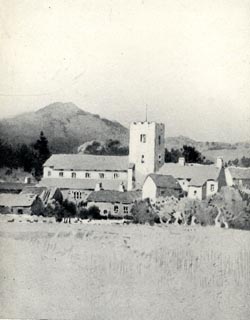 click to enlarge
click to enlargeRSN134.jpg
Tipped in opposite p.198 of Wordsworthshire by Eric Robertson.
printed at bottom:- "CHURCH OF BOWNESS-ON-WINDERMERE IN 1806 / (From an old print)"
item:- JandMN : 197.35
Image © see bottom of page
placename:- Bowness Church
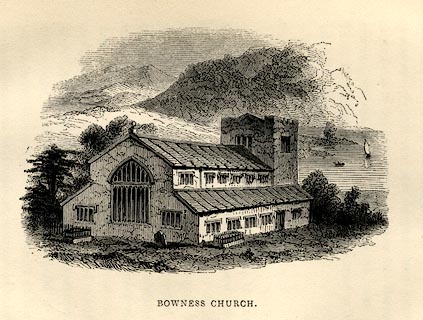 click to enlarge
click to enlargeJP1E05.jpg
Tipped in opposite p.25 of a Sketch of Furness and Cartmel, by Charles M Jopling.
item:- Armitt Library : A1636.6
Image © see bottom of page
 ring of bells
ring of bells sentences from scripture, wall painting
sentences from scripture, wall painting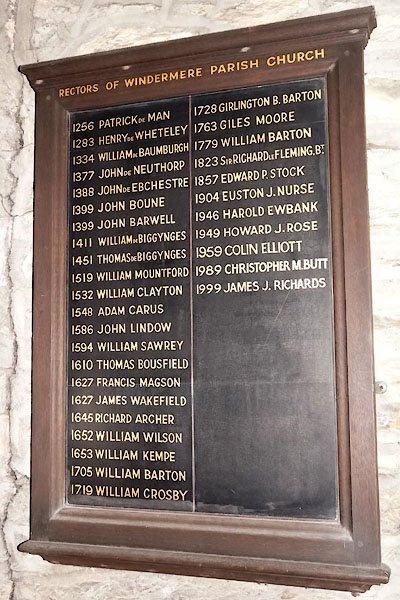
CCB98.jpg List of rectors.
(taken 12.11.2014)
 sundial
sundial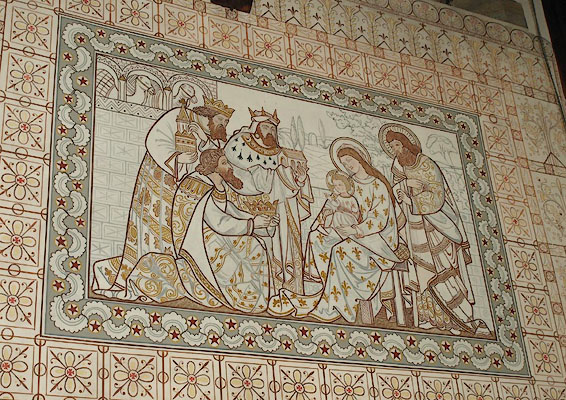
BRL41.jpg Wall painting in nave.
(taken 18.9.2009)
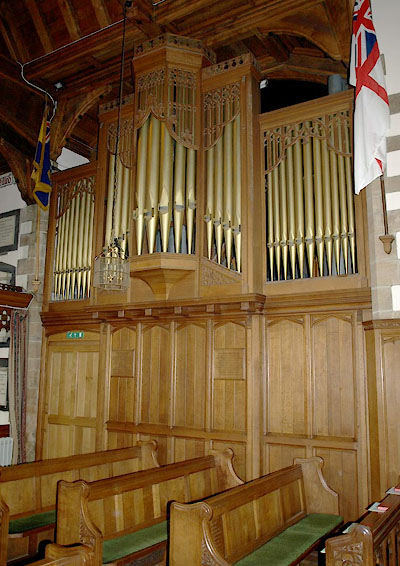
BRL44.jpg organ built by Jardine and Co, 1922, restored by Cowin Ltd, 1964 and again by V Saville, 1999.
(taken 18.9.2009)
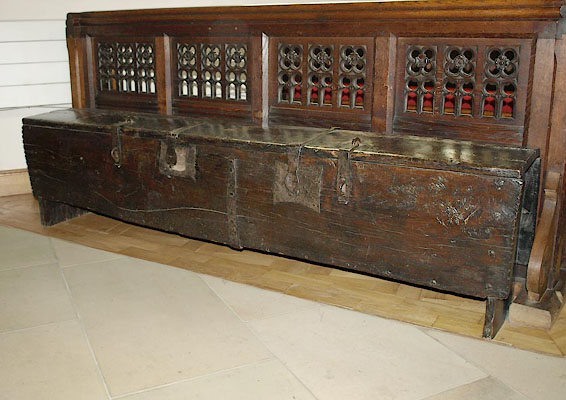
BRL50.jpg Chest.
(taken 18.9.2009)
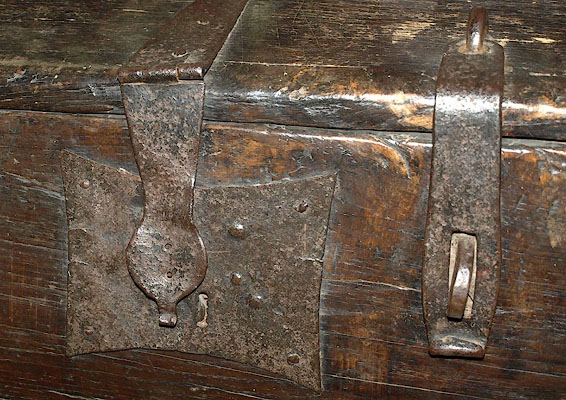
BRL51.jpg Chest.
(taken 18.9.2009)
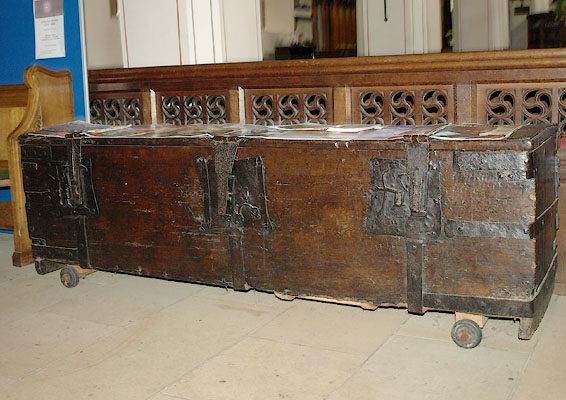
BRL54.jpg Chest.
(taken 18.9.2009)
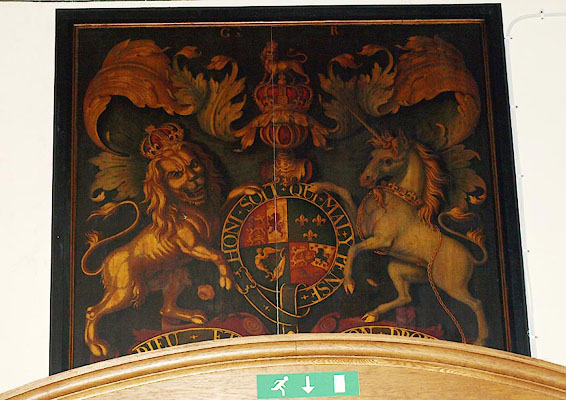
BRL53.jpg Royal coat of arms.
(taken 18.9.2009)
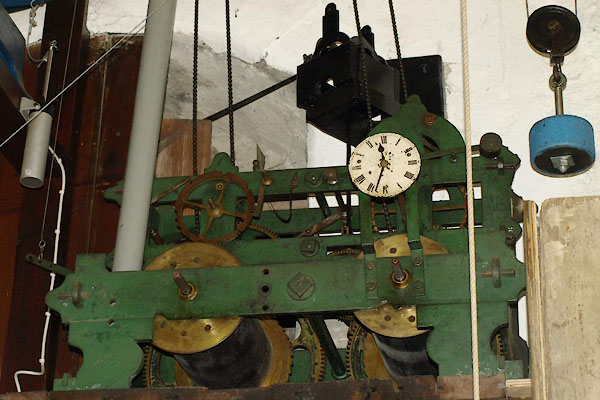
BWE57.jpg Turret clock.
(taken 5.4.2012) courtesy of the Rector.
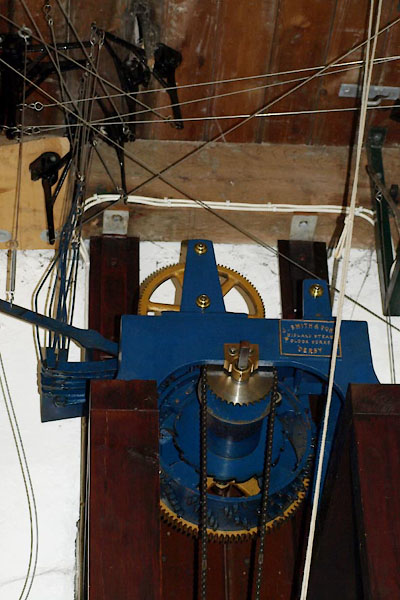
BWE58.jpg Musical work, J Smith and Sons, Derby.
(taken 5.4.2012) courtesy of the Rector.
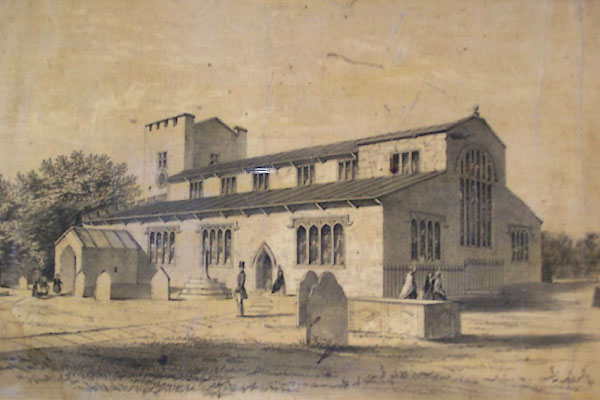
BNW16.jpg St Martin's Church, drawn by C J Greenwood, lithographed by R Groom, published by R Forest, Bowness on Windermere, 1830.
(taken 27.6.2007)
: Paley, Edward G
: Austin, Hubert J
to 1873
: Baddeley, Mountford J B
